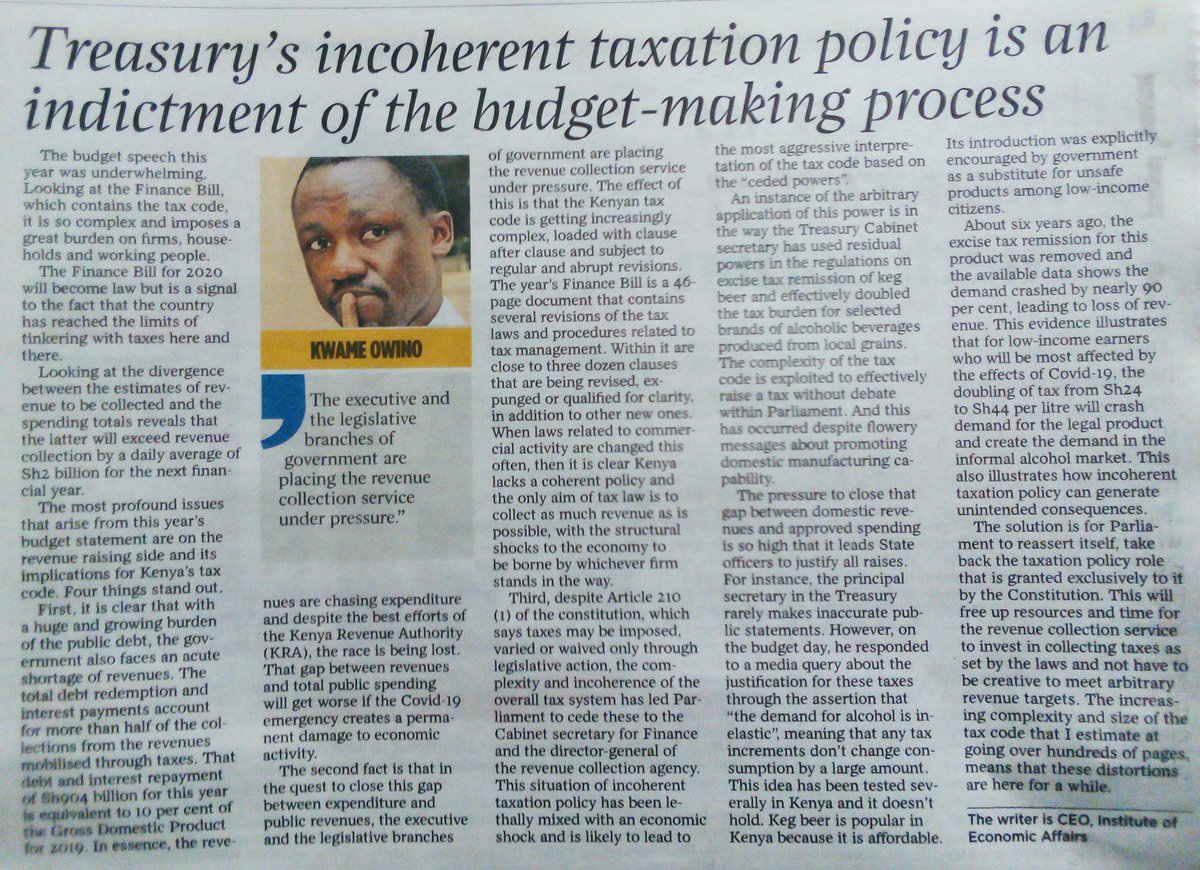
Our tweet chat is starting in 3 minutes! @j2mutua and colleagues @WNWamalwa @DJattani @RaphaelMuya3 will lead the conversation. #KEBudget2022_23
Kenya’s economy is projected to rebound to 6.0 percent in 2021. The recovery in 2021 is on account of the reopening of the economy which is expected to increase economic activities and also partly reflects lower base of 2020 #KEBudget22_23
The economy contracted by 0.3% in 2020 from a growth of 5.0% in 2019 following the adverse impact of COVID-19 pandemic and the resultant containment measures #KEBudget2022_23
The National Accounts were revised and rebased in 2020 where the base year was changed from 2009 to 2016 #KEBudget2022_23
The contraction in 2020 was spread across all sectors of the economy but was more dismal in Accommodation and Restaurant Services activities, Education, and Transport sectors #KEBudget2022_23
Aggregate Annual Tax Revenue has been declining relative to GDP, having declined from 18% in 2016/17 to 13.7% in 2020/21, this is explained by the structural challenges in the economy and expenditure in unproductive areas #KEBudget2022_23
Actual tax revenue in 2020/21 amounted to Ksh 1.56 Trillion (13.7% of GDP), in 2021/22 preliminary projection are Ksh 1.8 Trillion (14.3% of GDP) and in 2022/23, the latest projection is Ksh 2.14 Trillion (15.3% of GDP) #KEBudget2022_23
In 2022/23, cumulative revenue is expected to improve nominally, this is attributed to the improved business environment following the reopening of the economy and ease on measures put in place to contain the spread of the COVID-19 pandemic #KEBudget2022_23
The fiscal deficit was 8.0% of GDP in FY 2021/22, and according to Budget Policy Statement by The National Treasury, it is expected to improve to 6.0% of GDP in FY 2022/23 and further to 3.9 percent of GDP in FY 2024/25 #KEBudget2022_23
Actual total expenditure in 2020/21 amounted to Ksh 2.75 Trillion (24.3% of GDP), in 2022/23 preliminary projections are Ksh 3.3 Trillion (23.7% of GDP) #KEBudget2022_23
From the aggregate figures of total expenditure, the projection of the fiscal deficit of 6.0% of GDP is likely not to be feasible, due to challenges in the revenue mobilisation #KEBudget2022_23
Further fiscal tightening is required in implementing a fiscal consolidation plan, so as to lower the fiscal deficit and slow down debt accumulation #KEBudget2022_23
The consecutively high fiscal deficit further complicates the fiscal consolidation agenda and thus derailing Kenya’s path to the East Africa Community convergence target of 3% by 2023/24 #KEBudget2022_23
The consecutive fiscal deficits have resulted in the burgeoning of Consolidated Fund Services (CFS), which is mainly composed of public debt servicing, having increased from 21% in 2016/17 to 36% in 2021/22 #KEBudget2022_23
The national executive (MDAs) takes the largest share of total expenditure outlay, 52% in 2021/22 a markedly drop from 66% in the previous financial year, squeezed by the burgeoning CFS #KEBudget2022_23
Proportion wise, the proportion of the county allocations have declined from 11% in 2016/17 to 10% in 2021/22 #KEBudget2022_23
On average, most disbursements of funds to Ministries, Departments and Agencies are delayed in Q1 and are received late in Q4 signalling delays. This macro picture is likely to be experienced during budget implementationt
#KEBudget2022_23
#KEBudget2022_23
As illustrated, development budget is disproportionately affected than recurrent (for over the six years shown above, 14% of development funds were received in Q1 compared to recurrent’s 22%) #KEBudget2022_23
Delay in the disbursement of funds negatively affects the implementation of planned programmes by MDAs and subsequently the timely delivery of services #KEBudget2022_23
It is recommended that the National Treasury should consider the seasonality in the revenue collections in designing annual workplans and cash flow projections to improve on the timing of the releases in order to enhance effective service delivery #KEBudget2022_23
Delays in the disbursement of funds have disrupted budget implementation among the MDAs due to inadequate funding #KEBudget2022_23
In 2019/20, audited financial reports show that MDAs such as State Department for University Education did not receive funds totaling to Ksh 15.5 Bn, followed by Ministry of Water and Sanitation (Ksh 15.5 Bn), State Department for Interior (Ksh 13.6 Bn) #KEBudget2022_23
There is need for @KeTreasury to have a more accurate forecasting of revenue #KEBudget2022_23
#KEBudget2022_23 should enhance investment in more productive sectors of the economy to spur revenue mobilization
Weak oversight of the budget implementation in areas such as the State Owned Enterprises (SOEs) is likely to undermine the Economic Recovery Programme spearheaded by the @KeTreasury. This is an area that the current #KEBudget2022_23 should consider
The fiscal deficit in the current #KEBudget2022_23 of about Ksh 0.9 billion, has reduced from the previous financial year, however, is still relatively high given the consecutive deficits in the past
Persistent deficits in the current #KEBudget2022_23 is likely to further create macroeconomic instability especially on the exchange rate and general price levels, thus affecting livelihoods
In order to minimise on the frequency at which the #BudgetKE are revised through the supplementary budgets, @KeTreasury should enhance revenue forecasting; @NAssemblyKE should provide adequate review of the #KEBudget2022_23
#KEBudget2022_23
See financial burden state owned enterprises (SoEs) is imposing on the government🔗ieakenya.or.ke/?wpdmdl=2574. In #KEBudget2022_23, dissolution of loss making and non priority SoEs is inevitable, however unpopular it may be.

See financial burden state owned enterprises (SoEs) is imposing on the government🔗ieakenya.or.ke/?wpdmdl=2574. In #KEBudget2022_23, dissolution of loss making and non priority SoEs is inevitable, however unpopular it may be.


• • •
Missing some Tweet in this thread? You can try to
force a refresh











